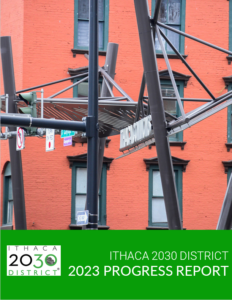We’re excited to present the fifth annual progress report for the Ithaca 2030 District.
As the report shows, the District as a whole in 2023 reduced its energy consumption by 37% from the baseline and realized a savings of 46% in water use. Thus, at the end of last year we surpassed both the 2025 energy and water targets for the first time.

How important are buildings to achieving the city-wide goal of carbon neutrality by 2030? The latest greenhouse gas inventory showed that buildings in the city make up an estimated 58% of emissions in Ithaca, with the commercial sector contributing 38%. Clearly, the success of the Ithaca Green New Deal depends in great measure on dramatically reducing the carbon footprint of our buildings.The Ithaca 2030 District—the flagship program of the Tompkins County Climate Protection Initiative (TCCPI)—is a voluntary effort by property owners and tenants to improve the energy and water performance of their buildings as well as to bring about cuts in commuter transportation emissions.
The District continues to grow rapidly. Currently, there are 55 member buildings and 922,298 square feet of committed space, compared to 33 buildings and 417,089 square feet in 2021.That’s a 66% increase in the number of buildings and 121% growth in committed square footage. For the purposes of this annual report, we focus on the 30 property members, 43 buildings, and 583,269 square feet that belonged to the District at the end of 2023.
Commuter emissions remained an area of concern in 2023, as it was in 2022. There was, however, an improvement: they dropped from 1706 kg CO2e/commuter/year in 2021 to 1421 in 2022 and 1403 in 2023, a 17.7% reduction in three years and significantly below the pre-pandemic level of 1,603. We still remain above the 2020 target of 1200, but at least now we’ve been heading in the right direction for two years.
Besides the annual district-level report, each of the property members is provided access to a confidential interactive, dynamic dashboard that measures the energy and water performance of their individual buildings. These dashboards are regularly updated so that building owners and tenants can monitor their progress towards the individual 2030 energy and water targets.
Check out the full 2023 report for details about the progress and growth of the Ithaca 2030 District.
